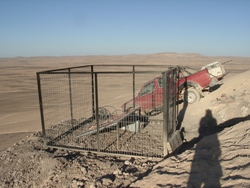Mar 16 2010
The recent high-intensity earthquake in southern Central Chile has resulted in the closure of one of the two seismic gaps left in the South American continent plate boundary.
 Integrated Plate Boundary Observatory in Chile
Integrated Plate Boundary Observatory in Chile
This last gap located in north of Chile currently has the potential for a relatively strong earthquake, and thus garners the attention of seismic scientists. The gap is being monitored by the GFZ German Research Centre for Geosciences since 2006 at the Chile-based Integrated Plate Boundary Observatory (IPOC).
Professor Reinhard Huettl, Chairman of the GFZ Board, has recently handed over the IPOC to the Universidad de Chile and the Universidad Catolica del Norte. Huettl informed that the GFZ, along with its Chilean coworkers and the rest of the partners, had established and operated the IPOC. Huettl added that the handing over of the Chilean Earthquake Service will increase cooperation among the partners. Huetto claims the IPOS will be jointly operated by these partners, while the German share in the IPOC will be financed by GFZ. The recent 27 Febraury quake confirms the ideal selection of the location for the IPOC. Huettl revealed that the remaining intact part of the crust of the Earth located away from the west coast of Chile has attracted the attention of geosciences researchers worldwide. Besides earthquakes, researchers aim to continually measure all processes related to plate boundary dynamics.
About a third of global seismic energy was released through earthquakes in the last century. Earthquakes along the Pacific plate boundary in the South American region peaked to magnitudes greater than M=8. The frequency of large-scale earthquakes in the South American region is shorter as compared to other regions on the Earth.
The work related to equipping the seismic observatory is collaborated by the GFZ (Potsdam), Universidad de Chile (Santiago), the IPGP (Paris), and the Universidad Católica del Norte (Antofagasta). Activities at the IPOC is being coordinated by Professor Onno Oncken, Director of the Department ‘Geodynamics and Geomaterials’ at the GFZ (Helmholtz Association).
While explaining the development of the observatory, Oncken revealed that presently, the monitoring network incorporates 20 seismological stations that are provided with acceleration sensors as well as broadband seismometers. Special care was taken to select the exact location for the IPOC for meeting the need for efficiency and dissolution of sensors, along with data capture. A 5m lug was blown inside the rock bed at each station for ensuring stable site environment for the installation of monitoring instruments. State-of-the-art GPS instruments have been provided at every seismic installation. Besides these instruments, seven measuring points were provided with magnetotelluric measuring instruments for measuring electric current within the crust of the Earth.
A powerful earthquake in this area can have dire consequences for the economy worldwide. The subduction of the South American Pacific floor is responsible for earthquakes in the region. A similar process also results in the creation of ore deposits in the crust of the Earth. This implies that the western boundary region of the Central Andes will contain the world’s largest copper deposit.